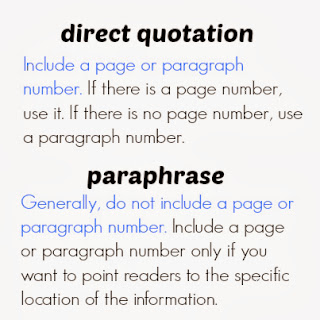APA Page Numbers Explained
Student
writers often send us questions about page numbers: When do I need to include a
page number in a citation? What if there is no page number? What if there is no
page number and no paragraph number? Can I include a page number with a paraphrase?
The Shorter Answer
The Longer Answer
When directly quoting a source, you’re using the author’s words,
word order, punctuation, and even mistakes in the same way they appear in the
source. If a reader wants to find that quotation, perhaps to see the context
around the quotation in the original source, he or she is going to want to find
the quotation quickly and will need a page or paragraph number to do so.
When you paraphrase, however, you
are often using information or ideas that appear in more than one place in a
source. Pointing readers to all 21 pages where they can find the information
you paraphrased would be more annoying than helpful. Just imagine if all of
your citations looked like this: (Shiell, 2013, p. 3, 4, 5, 15, 17, 20, 21, 22,
34, 41, 42, 43, 47, 59, 60, 64, 65, 98, 101, 102, 103). However, to direct
readers to the exact location of the information you’re paraphrasing—perhaps a
statistic, for example, or a small portion of a large work—APA suggests
including a page or paragraph number in your citation.
What if the Source Doesn't Have a Page or a Paragraph Number?
Web pages typically do not use
page numbers, so students often mistakenly label a web page as p. 1. Or,
they might print the web page and use the page numbers assigned by their
printer. The trouble with this method is that different printers assign
different numbers to the pages, potentially creating confusion for readers.
If the source doesn’t have a page
number, APA says to use a paragraph number. Many web pages don’t have numbered
paragraphs, though, and can contain numerous paragraphs. If the purpose of
providing a page or paragraph number is to easily direct readers to the
information you used, expecting readers to count each paragraph in the source
until they find para. 103 defeats the point. In such cases, APA says writers
can use a heading or a section description and count the paragraph underneath
it.
Here's an example. Like many
webpages, the CDC
page on Worker Safety During Fire Cleanup page does not have page numbers or numbered paragraphs,
but the information is organized by sections with headings. To cite information
about the primary types of electrical injury, which is located in the first
paragraph after the heading Electrical Hazards, your parenthetical citation
would look like this: (CDC, 2013, “Electrical Hazards,” para. 1).* Readers
familiar with APA will know (or can figure out) that the citation points to the
first paragraph after the Electrical Hazards heading.
*This citation assumes that this
is not the first time you are citing the CDC in your paper. For information on
how to format citations for sources that use an acronym, see this page.
For more detail on these page and
paragraph number rules, see pages 171-172 and 179 in the 6th edition of
the APA manual. Do you have other questions about page and paragraph numbers?
Let us know in the comments!
Other posts you might like:
Demystifying In-Text vs. Parenthetical CitationsAPA Citations: The Method to the Madness
What's the Citation Frequency, Kenneth?
Citing an Author Throughout a Paragraph: Notes on a Tricky APA Shortcut
When to Use an Author Name in the Body of a Sentence and When to Keep It in the Parenthetical Citation
Subscribe to:
Post Comments
(
Atom
)






No comments :
Post a Comment